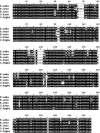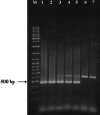Cloning and sequencing of the ompA gene of Enterobacter sakazakii and development of an ompA-targeted PCR for rapid detection of Enterobacter sakazakii in infant formula
- PMID: 16597955
- PMCID: PMC1449048
- DOI: 10.1128/AEM.72.4.2539-2546.2006
Cloning and sequencing of the ompA gene of Enterobacter sakazakii and development of an ompA-targeted PCR for rapid detection of Enterobacter sakazakii in infant formula
Abstract
Enterobacter sakazakii is an emerging, infant formula-borne pathogen that causes severe meningitis, meningoencephalitis, sepsis, and necrotizing enterocolitis in neonates and infants, with a high fatality rate. Traditional detection methods take up to 7 days to identify E. sakazakii. The outer membrane protein A gene (ompA), along with its flanking sequences from E. sakazakii (ATCC 51329), was cloned in the pGEM-T Easy vector and sequenced. Comparison of the nucleotide and deduced amino acid sequences of the ompA gene with other sequences available in the GenBank database revealed a high degree of homology with ompA genes of other gram-negative bacteria belonging to the Enterobacteriaceae. Based on regions of the ompA gene unique to E. sakazakii, two primers were synthesized to develop and optimize an E. sakazakii-specific PCR. The PCR amplified a 469-bp DNA product from all E. sakazakii strains tested but not from other bacteria. Experiments to determine the sensitivity of the PCR indicated that it could detect as few as 10(3) CFU/ml of E. sakazakii bacteria in infant formula directly and 10(-1) CFU/ml after an 8-h enrichment step. We conclude that this PCR, combined with enrichment culturing, has the potential to be used as a rapid tool for detecting the presence of E. sakazakii in infant formula.
Figures






Similar articles
-
Development of an immobilization and detection method of Enterobacter sakazakii from powdered infant formula.Food Microbiol. 2008 Aug;25(5):648-52. doi: 10.1016/j.fm.2008.04.001. Epub 2008 Apr 12. Food Microbiol. 2008. PMID: 18541162
-
Rapid, specific detection of Enterobacter sakazakii in infant formula using a real-time PCR assay.J Food Prot. 2005 Jan;68(1):59-63. doi: 10.4315/0362-028x-68.1.59. J Food Prot. 2005. PMID: 15690804
-
Isolation of Cronobacter spp. (formerly Enterobacter sakazakii) from infant food, herbs and environmental samples and the subsequent identification and confirmation of the isolates using biochemical, chromogenic assays, PCR and 16S rRNA sequencing.BMC Microbiol. 2009 Oct 27;9:225. doi: 10.1186/1471-2180-9-225. BMC Microbiol. 2009. PMID: 19860874 Free PMC article.
-
Cronobacter species (formerly known as Enterobacter sakazakii) in powdered infant formula: a review of our current understanding of the biology of this bacterium.J Appl Microbiol. 2012 Jul;113(1):1-15. doi: 10.1111/j.1365-2672.2012.05281.x. Epub 2012 Apr 11. J Appl Microbiol. 2012. PMID: 22420458 Review.
-
Enterobacter sakazakii and other bacteria in powdered infant milk formula.Matern Child Nutr. 2005 Jan;1(1):44-50. doi: 10.1111/j.1740-8709.2004.00008.x. Matern Child Nutr. 2005. PMID: 16881878 Free PMC article. Review.
Cited by
-
Isolation and Identification of Cronobacter spp. from Fish and Shellfish Sold in Retail Markets.Curr Microbiol. 2021 May;78(5):1973-1980. doi: 10.1007/s00284-021-02447-3. Epub 2021 Mar 27. Curr Microbiol. 2021. PMID: 33774683
-
Novel Development of a qPCR Assay Based on the rpoB Gene for Rapid Detection of Cronobacter spp.Curr Microbiol. 2016 Apr;72(4):436-43. doi: 10.1007/s00284-015-0971-y. Epub 2015 Dec 31. Curr Microbiol. 2016. PMID: 26721831
-
Enterobacter sakazakii: an emerging pathogen in infants and neonates.Surg Infect (Larchmt). 2008 Oct;9(5):533-9. doi: 10.1089/sur.2008.006. Surg Infect (Larchmt). 2008. PMID: 18687047 Free PMC article. Review.
-
Cronobacter sakazakii and Microbiological Parameters in Dairy Formulas Associated With a Food Alert in Chile.Front Microbiol. 2018 Jul 31;9:1708. doi: 10.3389/fmicb.2018.01708. eCollection 2018. Front Microbiol. 2018. PMID: 30108565 Free PMC article.
-
A robotic DNA purification protocol and real-time PCR for the detection of Enterobacter sakazakii in powdered infant formulae.BMC Microbiol. 2006 Dec 13;6:100. doi: 10.1186/1471-2180-6-100. BMC Microbiol. 2006. PMID: 17166252 Free PMC article.
References
-
- Bar-Oz, B., A. Preminger, O. Peleg, C. Block, and I. Arad. 2002. Enterobacter sakazakii infection in the newborn. Acta Paediatr. 90:356-358. - PubMed
-
- FSNET. 8. November 2002, posting date. Recalled baby formula found in Colorado stores. Colorado Department of Public Health and Environment. [Online.] http://archives.foodsafetynetwork.ca/fsnet/2002/11-2002/fsnet_november_8...#RECALLED%20BABY.
-
- Guillaume-Gentil, O., V. Sonnard, M. C. Kandhai, J. D. Marugg, and H. Joosten. 2005. A simple and rapid cultural method for detection of Enterobacter sakazakii in environmental samples. J. Food Prot. 68:64-69. - PubMed
-
- Himelright, I., E. Harris, V. Lorch, M. Anderson, T. Jones, A. Craig, M. Kuehnert, T. Forster, M. Arduino, B. Jensen, and D. Jernigan. 2002. Enterobacter sakazakii infections associated with the use of powdered infant formula—Tennessee, 2001. Morbid. Mortal. Wkly. Rep. 51:297-300. - PubMed
Publication types
MeSH terms
Substances
Associated data
- Actions
LinkOut - more resources
Full Text Sources
Other Literature Sources
Medical
Molecular Biology Databases

